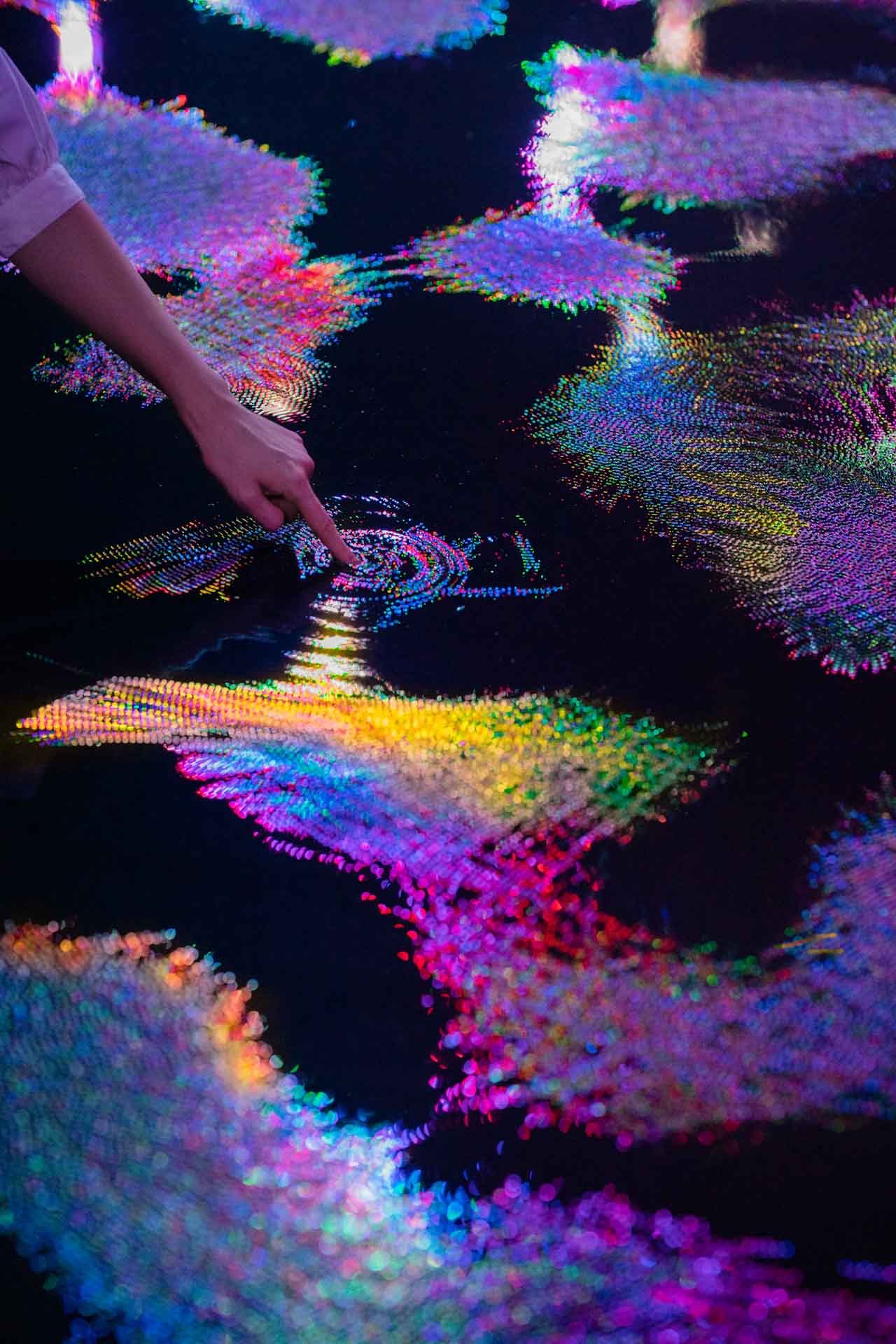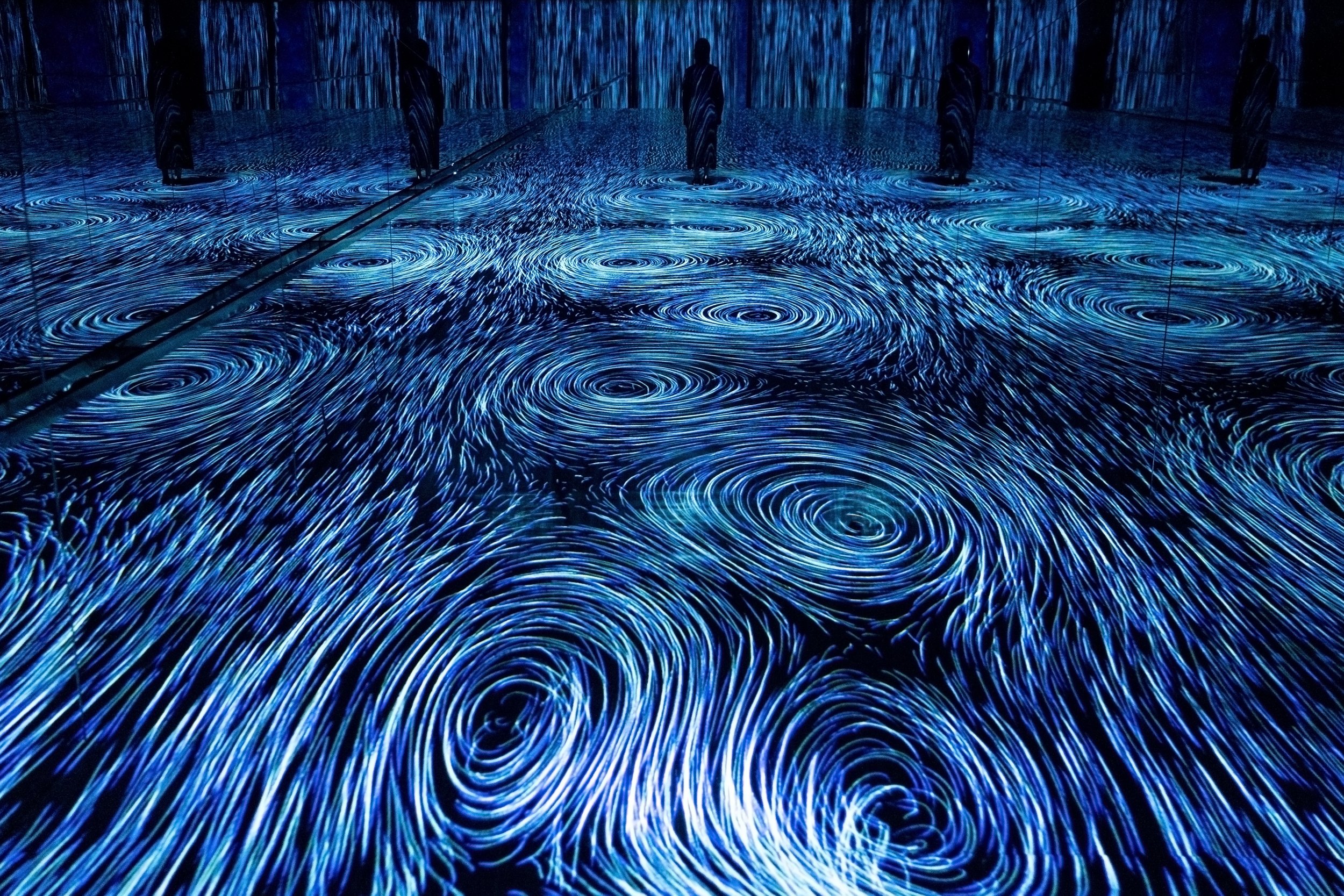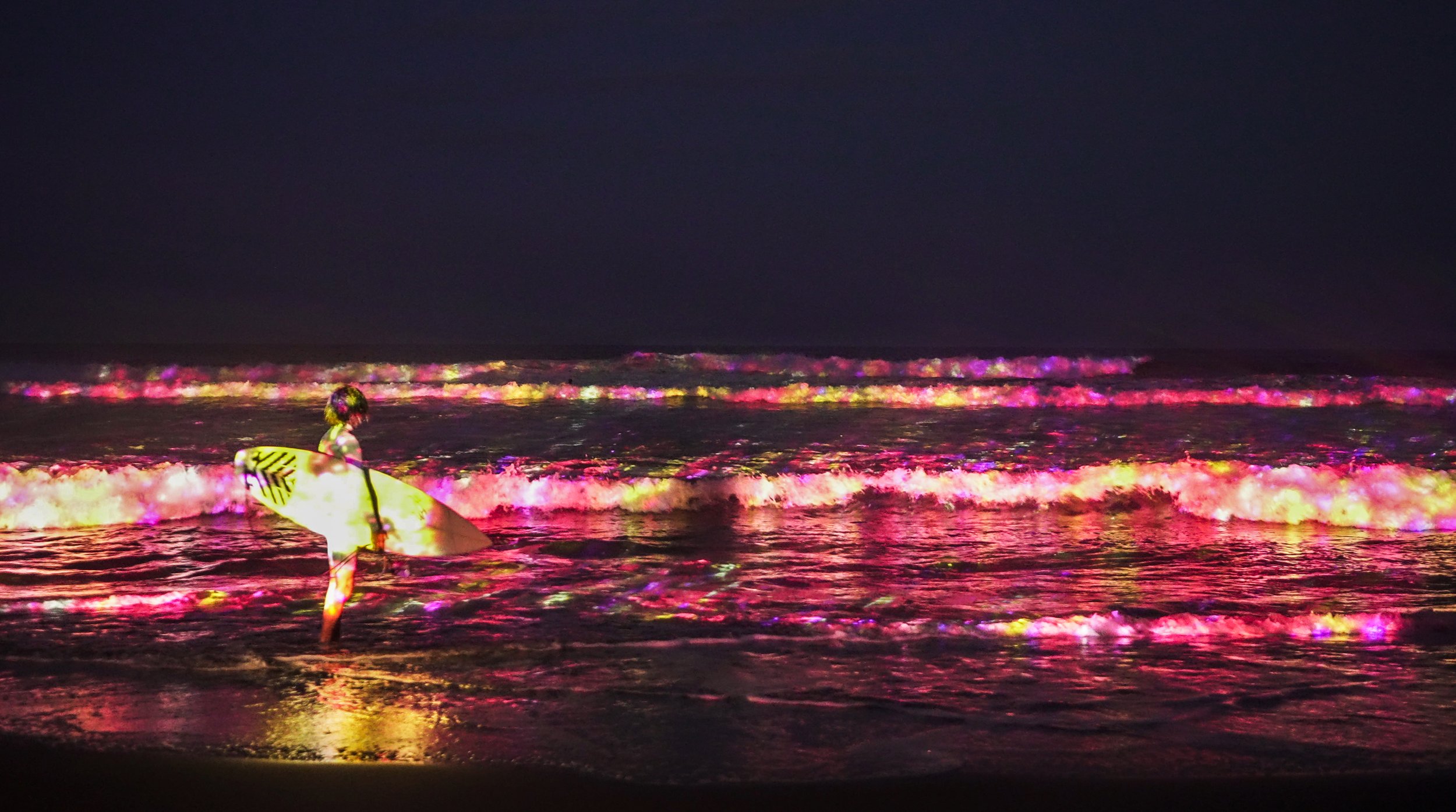12 SPOTLIGHT: teamLab
Living Crystallized Light, teamLab, 2022, Interactive Installation, Sound: teamLab ©️ teamLab, courtesy Pace Gallery
The Tokyo-based international art collective teamLab have built a worldwide reputation for crowd-pleasing immersive environments, and teamLab Borderless: MORI Building Digital Art Museum, Tokyo, broke the record as the world’s most visited single artist museum. Not only do teamLab work at the scientific cutting edge of the latest technology to create artworks, they use it to give fresh perspectives on such phenomena as the nature and causes of ocean currents. Science goes to the disco, you might say … the more so as the boundaries between art and viewer break down: you don’t look at works by teamLab, you become part of them.
What’s the story of teamLab?
It was founded in 2001 by Toshiyuki Inoko and several of his friends, to create a ‘lab’, a space for co-creative activities. By putting ourselves in such an environment, we wanted to deepen our thoughts and insights, simply to keep creating. We want to create a new experience, and through such experience, we want to explore what the world is for humans.
teamLab has been creating digital art from the beginning. Our aim has always been to change people’s standards of value and contribute to societal progress. That hasn’t changed since the very start. We create as a team. Ever since teamLab was founded, we’ve seen it as a laboratory to experiment in collective creation.
However, we lacked both opportunities to present our work, and the ability to economically sustain our teams producing art. On the other hand, we believed in the power of digital technology and creativity, and we simply loved it. We just wanted to keep creating something new, no matter which genre it would turn out to be. And while we took part in various projects to maintain teamLab, we increased the number of technologists involved - such as architects, CG animators, painters, mathematicians and hardware engineers.
As time went on, teamLab gained passionate followers but was still ignored by the art world. Its debut finally came in 2011 at the Kaikai Kiki Gallery in Taipei, to which the collective was invited by the artist Takashi Murakami. Since then, teamLab has gained opportunities to join major contemporary art exhibitions in cosmopolitan cities starting with the Singapore Biennale 2013. And in 2014, New York’s Pace Gallery started to promote teamLab artworks. These fortunate factors allowed teamLab to expand rapidly, and in 2015, the collective was finally able to organize its own exhibition for the first time, in Tokyo. That led to opportunities to exhibit internationally: New York, London, Paris, Singapore, Silicon Valley, Beijing, Taipei, and Melbourne among others. As of today, teamLab has welcomed over 28 million visitors to its art exhibitions worldwide.
What do you seek through your particular combination of science and art?
teamLab aims to explore the relationship between the self and the world and new perceptions through art. In order to understand the world around them, people separate it into independent entities with perceived boundaries between them. teamLab seeks to transcend these boundaries in our perception of the world, of the relationship between the self and the world, and of the continuity of time. Everything exists in a long, fragile yet miraculous, borderless continuity of life.
How important is technology in realising those aims?
We could say that technology is the core of our artworks, but technology is not the most important part. It is still just a material or tool for artworks. Digital technology allows artistic expression to be released from the material world, enabling form to be changed freely. The environments where viewers and artworks are placed together allow us to decide how to express those changes. And teamLab believes that the digital domain can expand the capacities of art, and that digital art can create new relationships between people.
In art installations with the viewers on one side and interactive artworks on the other, the artworks themselves undergo changes caused by the presence and behaviour of the viewers. This has the effect of blurring the boundaries: the viewers actually become part of the artworks themselves. The relationship between the artwork and the individual then becomes a relationship between the artwork and the group. Whether or not another viewer was present within that space five minutes before, or the particular behaviour exhibited by the person next to you, suddenly become elements of great importance. At the very least, compared to traditional art viewing, people will become more aware of those around them. That's right – art now has the ability to influence the relationship between the people standing in front of the artworks.
How do you make the work?
Our artworks are created by a team of hands-on experts through a continuous process of creation and thinking. Although the large concepts are always defined from the start, the project goal tends to remain unclear, so we need the whole team to create and think as we go along. teamLab's organisational structure seems flat at a first glance, but it is also extremely multidimensional, with an underlying layer that is unclear and undecided. The goal of the artwork becomes more clearly defined as the team progresses its work.
You emphasise the concept of ‘Environmental Phenomena’. How does that operate?
teamLab explores the creation of artworks in which the artworks do not exist independently, but are created by the environment that produces the various phenomena. Objects like stones and man-made creations maintain a stable structure on their own. Unlike these, the existence of the artworks is dependent on their environment. The environment produces phenomena and stabilises their structure - these stabilised phenomena are what make the artworks exist. For example, in Living Crystallized Light people can walk into the artwork, and even if they do so, the artwork will continue to be maintained, its existence unharmed. If a person touches the artwork, they realise that what they are looking at is ordinary water. The artwork’s existence is not independent, but is actually a unique phenomenon created by its environment.
Environmental phenomena are released from the material substances that have been responsible for maintaining structures of existence. Elements like air, water, and light that permeate our daily lives are transformed by their environment into unique phenomena that become works of art. The boundaries of their existence are ambiguous and continuous. Even if people destroy the work, it will remain in existence as long as its environment is maintained. On the contrary, the work will disappear if the environment is not maintained.
In time, people's consciousness will expand from existence itself to the environment. A stone can continue to exist in a closed box, sealed off from the outside world, but life cannot sustain its existence in such a box because it is created by its environment. Life is a miraculous phenomenon that emerges from a flow in a continuous world.
Flowers Bloom When the Waves Rise - Sea of Shikoku, teamLab, 2021, Digitized Nature, Sound: Hideaki Takahashi, Surfer: Hironori Ichiraku, Cooperation: Atsushi Izumi, Kei Nakanishi, Reki Nagahara ©️ teamLab, courtesy Pace Gallery
How do you see Flowers Bloom When the Waves Rise - Sea of Shikoku, in which flowers bloom when the waves rise, then fall away as the waves become a part of the ocean once more?
When the waves rise, we can feel a powerful breath of life, as though life is blooming. It feels as though each wave has a life of its own. But when the waves collapse and disappear, we realise, with a sense of fragility, that they were a part of the ocean. And that ocean is connected to all of the other oceans. In other words, all of the waves in the world are connected to each other. The waves seem alive because life is like a rising wave. It is a miraculous phenomenon that continuously emerges from a single, continuous ocean.
What interests you about vortexes, and how was Existence in the Flow Creates Vortices created?
This fits with our interest in ‘Environmental Phenomena’. Complicated terrain such as an island splits the ocean and produces flow velocity difference, which generates a vortex. Naruto Whirlpools (the tidal whirlpools in the channel between Naruto in Tokushima and Awaji Island in Hyōgo, Japan) are visible, but there are many other massive vortices being generated by the islands in many other oceans. They are just too huge for us to see. It is actually this phenomenon called vortices that swirl up carcasses that have sunk to the bottom of the ocean. They also carry the nutrients of forests, flowing from rivers to create highly nutritious seawater that enables plankton to grow and nourishes sea life. Vortices therefore contribute to enriching the ocean. This tells us that islands that seem to have little influence on human life actually do have a great influence.
Although a vortex is steady, it is constantly moving and swelling like a powerful life-form. Despite the existence of the vortex being maintained, the water particles that form it change from moment to moment. The vortex that is being seen now is created by completely different water from the same vortex seen a few minutes ago. The vortex, unlike a rock, cannot maintain a stable structure on its own; rather, it is created and sustained by the energy of water that continuously flows inwards and outwards. A vortex looks like a life-form because life similarly consumes external energy and matter and discharges it, sustaining its ordered structure within that flow. Life is a miraculous vortex that emerges from a flow of energy in a continuous world.
teamLab, Existence in the Flow Creates Vortices, teamLab, 2022, Interactive Digital Installation, Endless, Sound: teamLab ©️ teamLab, courtesy Pace Gallery
In the artwork, vortices are created behind people as they climb against the flow. Water is depicted as a continuum of countless water particles, and the interactions between the particles are calculated to create a three-dimensional simulation of their movement. The vortices create lines from the trails of these particles. The collection of three-dimensional lines are then cut out using what teamLab calls ‘Ultrasubjective Space’. In contrast to space that is created through, or cut out by, lenses and perspective, Ultrasubjective Space does not fix the viewer’s viewpoint and in turn frees their body. The floor and walls that the vortices are seen on do not become a boundary between the viewer and the artwork, and the artwork space becomes continuous with the space in which the viewer’s body exists.
You can currently see teamLab’s work at many venues around the world, as set out here on their website.
All images and videos shown courtesy of teamLab ©️ teamLab - All rights reserved






